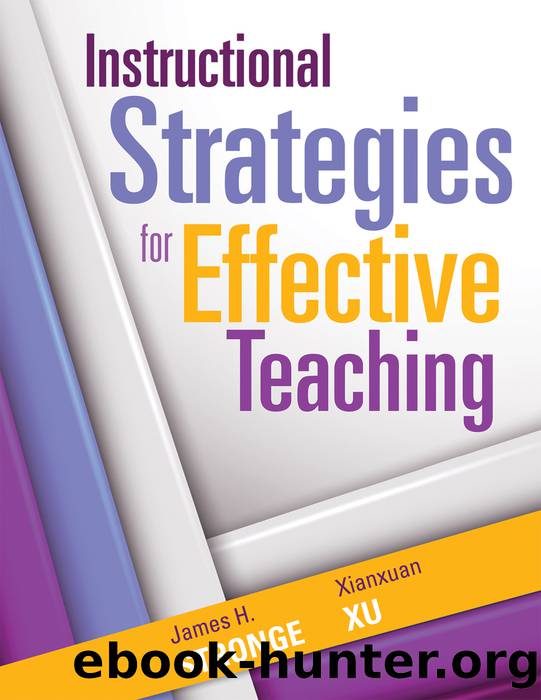Instructional Strategies for Effective Teaching by Stronge James H.;Xu Xianxuan;

Author:Stronge, James H.;Xu, Xianxuan;
Language: eng
Format: epub
Publisher: Solution Tree
Published: 2015-09-15T00:00:00+00:00
Chapter 6
Mastery Learning
Anyone who has taught knows that students learn in different ways and at different rates. One well-tested approach for addressing studentsâ unique learning needs is mastery learningâan instructional method that gives a detailed and personalized roadmap of expectations for each student. The basic features of mastery learning are:
⢠Preassessing student learning
⢠Developing appropriate learning objectives
⢠Providing individualized learning experiences
⢠Postassessing student learning progress
⢠Moving on if students achieve mastery
⢠Providing further instruction or learning experiences to attain mastery
In essence, this is a test-before-you-teach approach to designing and guiding instruction. In mastery learning, students continuously receive corrective feedback and advice for improvement from the teacher regarding their specified tasks. Also, teachers expect students to remain conscious of their present positions, their upcoming goals, and the ways they can bridge the gap between the two. In this manner, mastery learning takes student learning differences into accountâtheir prior achievements, learning styles, and learning pacesâand then sets individualized, specific, and sequential learning goals.
Most teachers are familiar with the instructional approach of mastery learning, especially with the contemporary focus on achieving mastery on state- or district-mandated curriculum goals. In a mastery learning classroom, the assessment approach is formative and individual-referenced, rather than criteria-referenced or norm-referenced like many other assessments. Additionally, the teacher avoids rote memory methods or superficial learning merely for the purpose of pushing students to a passing score on a high-stakes test. Mastery learning has many advantages; it:
⢠Ensures students have the prerequisite knowledge and skills before they move on with their learning
⢠Offers alternative learning opportunities, builds studentsâ success with learning, and breaks the cycle of failure
⢠Makes teachers more knowledgeable about the status of student learning, and guides and adjusts planning based on studentsâ needs
⢠Sets high expectations with meaningful learning objectives that every student can master
We attribute the application of mastery learning in education to, among others, Benjamin Bloom (1984). Although behaviorist learning modelsâsuch as mastery learningâtend to recall the stimulus-response conditioning experiments conducted by Ivan Pavlov and others, mastery learning is far from mechanistic. A key advantage of mastery learning, as compared with some cognitive models, is that it not only targets the content domain but also takes into account student readiness when targeting learning objectives. Additionally, teachers can use it to design and implement instruction that focuses on the student as an individualâanother key advantage in a results-oriented environment.
Download
This site does not store any files on its server. We only index and link to content provided by other sites. Please contact the content providers to delete copyright contents if any and email us, we'll remove relevant links or contents immediately.
The Art of Coaching Workbook by Elena Aguilar(48574)
Trainspotting by Irvine Welsh(20141)
Twilight of the Idols With the Antichrist and Ecce Homo by Friedrich Nietzsche(17758)
Fangirl by Rainbow Rowell(7895)
Periodization Training for Sports by Tudor Bompa(7377)
Change Your Questions, Change Your Life by Marilee Adams(6704)
This Is How You Lose Her by Junot Diaz(5845)
Grit by Angela Duckworth(4779)
Red Sparrow by Jason Matthews(4735)
Asking the Right Questions: A Guide to Critical Thinking by M. Neil Browne & Stuart M. Keeley(4643)
Paper Towns by Green John(4210)
Room 212 by Kate Stewart(4153)
Ken Follett - World without end by Ken Follett(4005)
The Sports Rules Book by Human Kinetics(3631)
Housekeeping by Marilynne Robinson(3460)
The Motorcycle Diaries by Ernesto Che Guevara(3381)
Exercise Technique Manual for Resistance Training by National Strength & Conditioning Association(3330)
Introduction to Kinesiology by Shirl J. Hoffman(3329)
Papillon (English) by Henri Charrière(3324)
